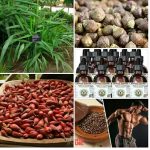Aframomum melegueta; synonyms: Alexis grandiflora, Amomum grana-paradisi, Cardamomum grandiflorum, Cardamomum grana-paradisi (Botanical name) or Meleguetta Pepper, Grains of paradise (English) or Goriya, Kumfa, Cìttáá kúmfáá (Hausa) or Pieprz Malagetta (Polish) or Atayéé, Atanre (Yoruba) or Ose oji (Igbo): A perennial deciduous herb with interesting history and medicinal values
DESCRIPTION AND OCCURRENCE: A. melegueta is a perennial deciduous herb native to the tropics and grows at the swampy habitats of the West Africa coast. It belongs to the Ginger family (Zingiberaceae). It possesses tufted leafy stem that can be up to 1.5 m high. The leaves are simple, alternate and lanceolate. The matured leaves can grow as long as 40 cm in length and 12 cm-15 cm wide. It produces purple coloured flowers, which develops into pods that can be as long as 8 cm and about 3 cm wide. This pod contains numerous reddish-brown seeds (can be as many as 300 seeds in one pod). The sharp and peppery taste of the seeds is caused by the aromatic ketones: 6-paradol, 6-gingerol and 6-shogaol present in it; these are the same compounds you can find in ginger (Cìttáá in Hausa). The fruits are fleshy, indehiscent and produce spikes. It cannot survive temperatures below 1°C. It is native to the West African region. This herb can be found in Nigeria, Uganda, Angola, Benin, The Gambia, Ghana, Guinea, Cote d’Ivoire (Ivory Coast), Liberia, Sierra Leone, Togo, Cameroon, Congo, Gabon, Gulf of Guinea Is., Democratic Republic of the Congo (Zaire), Guinea-Bissau, but widely cultivated in various parts of other tropical Africa, South America and several other places.
Nutritional value and health benefits of Grains of Paradise (Aframomum melegueta)
The heat is what has kept A. melegueta alive in people’s minds. It can be mixed with coriander, cinnamon (Kirfa in Hausa), dried chilies (shambo in Hausa) and cloves (Kanumfari in Hausa) as a condiment for grilled lamb, chicken, fish, pumpkin and okra, or added to soups, stews and pickling mixtures. They can also be found in ‘raz al hanout’, the spice mixture of Morocco.
The fruit pulp surrounding the seeds is eaten, or chewed as a stimulant. The root is a pungent, stimulant that benefits the digestion and relieves spasms.
A decoction is taken internally in the treatment of a range of disorders including painful menstruation, excessive lactation, postpartum haemorrhage (excessive bleeding during giving birth to a baby) and infertility.
The roots can be harvested throughout the year and used fresh or dried for later use.
Although used mainly as a condiment, the seeds also have a stimulant action on the digestive system, strengthening and warming the stomach.
They are used to alleviate indigestion, flatulence and bloating and help to relieve abdominal discomfort due to colic or griping.
The seeds can help to reduce or prevent vomiting and to bring relief from nausea. They have also been used as an aphrodisiac. THE USE OF THE SEEDS AS AN APHRODISIAC MAY BE DUE TO SOME STUDIES SHOWING AN IMPROVEMENT IN THE LEVEL OF TESTOSTERONE AND A DECLINE IN THE AMOUNT OF FEMALE HORMONES. FOR THIS REASON, THE SEEDS AND THEIR EXTRACT ARE SOLD AS SUPPLEMENT FOR BODYBUILDING.
The seed is used to treat head colds, influenza, slight abdominal pains, constipation, menstrual pains and rheumatism. Combined with Zingiber officinale (citta in Hausa), they are used to treat colds and fever. Crushed in citron juice, they are employed for treating glandular problems.
The pulverised seeds are used in an enema for treating constipation pains, and are mixed with mustard oil in an ointment for easing arthritis pains.
The seeds are pulverised with the seeds of Piper nigrum (black pepper) and then mixed with coconut oil to make an ointment that is used to treat general swellings and pains.
A decoction of the whole plant is used to treat menstrual pain. It is macerated with Justicia secunda in a decoction that is used as a laxative and a general medicine.
The expressed leaf juice is used to treat scrofula (tuberculosis of the neck). The seed contains the volatile oil paradol, which has antispasmodic, carminative and pectoral qualities.
This herb can be useful in the prevention and management of overweight and obesity thanks to the presence of gingerol, shogaol and piperine, which are known to increase metabolic rate. CULTURALLY, when a baby is born in Africa, for instance, in the Yoruba culture, a small amount is given to them to taste, this is done minutes after they are born.
It is said to be a welcoming process for the baby. It is also used as a traditional wedding gift in the same Yoruba culture.
In addition to this, A. melegueta together with kola nut is served to guests in the Eastern part of Nigeria.
When chewed together, the hot spicy taste enhances or reduces the bitter taste from the kola nut. A. melegueta is used for divination and ordeal to determine who is guilty of an offence among the Efik people (primarily Eastern part of Nigeria).
It is also used for religious (voodoo) rites at the Caribbean Islands.
One of the myths as regards this seed is that it prevents accident when swallowed and also reduce the state of drunkenness (you might give this myth a try when you feel tipsy BUT NOT with Accident!).
HISTORICALLY, The first known reference to the plant dates from 1214 A.D., there were remarks that physicians in places as far apart as the Frankish Court at Nicosia, Rome, Lyons and Wales included this plant in medical prescriptions.
Queen Elizabeth I of England was also noted to flavour her Beer with it. Around the 14th-15th Century, Pliny mentioned it to be African pepper and it was later referred to as Grains of Paradise when it became a popular substitute for Black pepper in Europe.
In 1469, it was given another name; Malagueta (a Portuguese word which literally means ‘chilli pepper’) and gained more popularity as it was included in the trade by a Portuguese merchant and explorer from Lisbon; Fernao Gomes, in the Gulf of Guinea following the permission of King Afonso V of Portugal.

Around these centuries, Menagier de Paris (French medieval book on a woman’s proper behaviour in marriage and running a household since 1393) recommended it for improving wine that smells stale, also, the present region now known as Liberia was named ‘Grains coast’ (adapted from Grains of paradise) because its seeds were major export item in the region at that period.
The first scientific publication on this plant was done by Karl Moritz Schumann on the 4th October, 1904. A. melegueta is also commonly called Guinea grains and ERRONEOUSLY ALLIGATOR PEPPER!
These are the thoughts of:
Sa’eed Halilu Bawa
Senior Lecturer (Associate Professor) at University of the West Indies, St. Augustine Campus, Trinidad.
Studied Food and Nutrition Sciences, Dietetics at Kaduna Polytechnic, Nigeria; Warsaw University of Life Sciences, Poland.
























